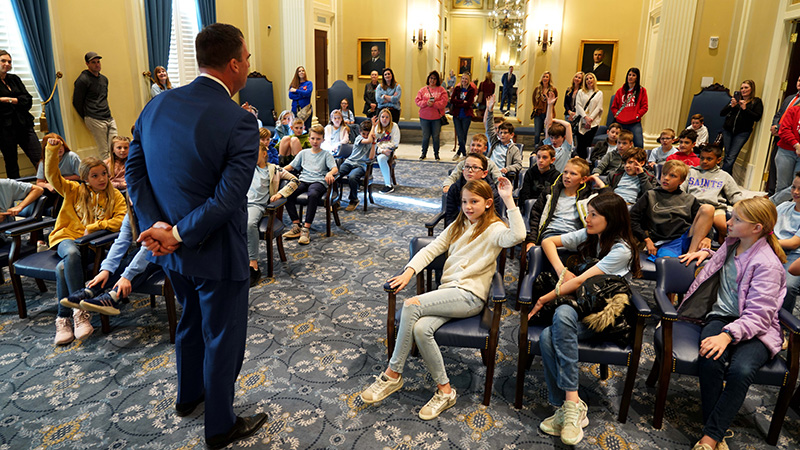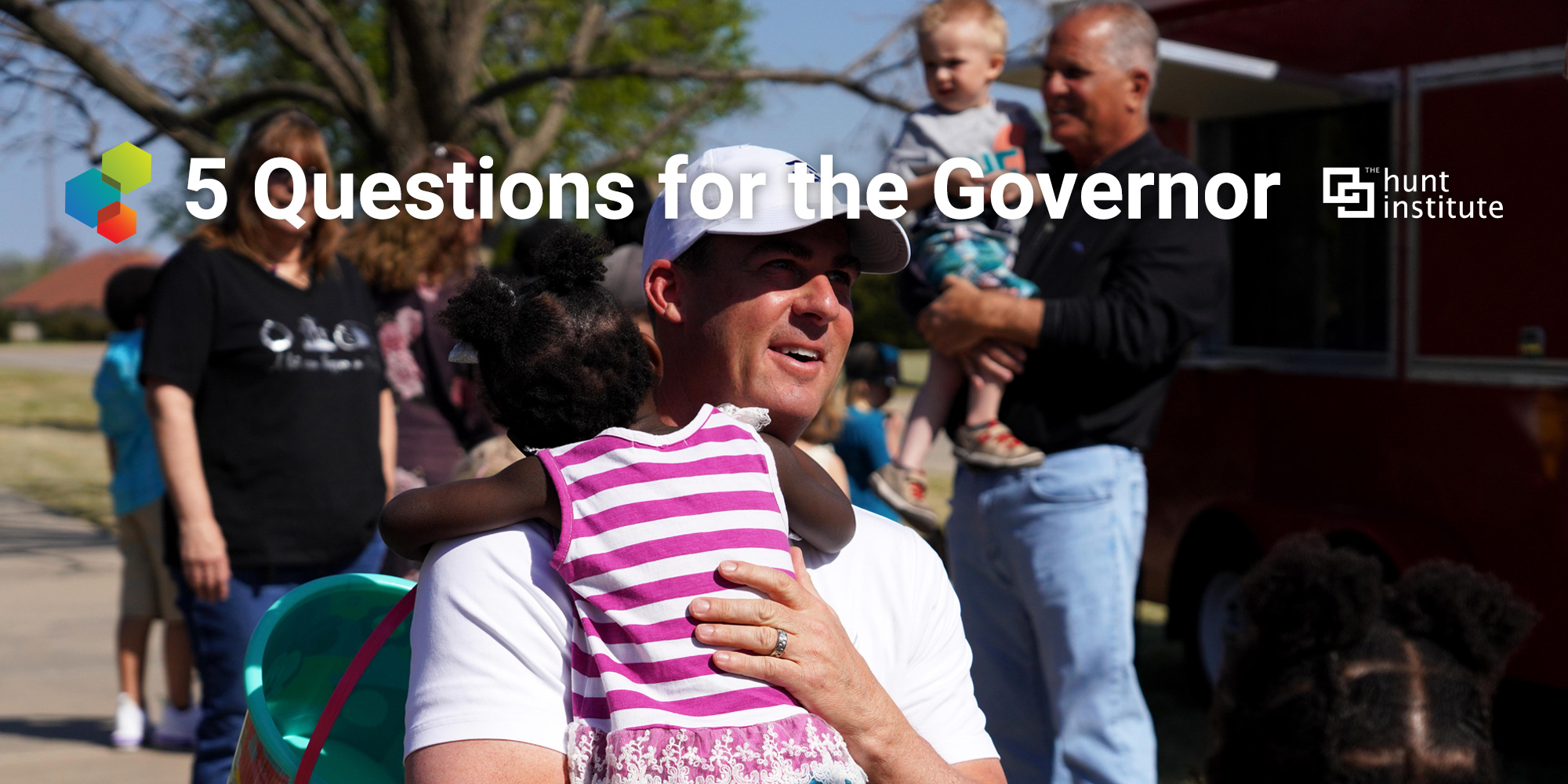Where do you go for the top news in Early Learning at the state level? Check out “5 Questions for the Governor,” where we explore the top Early Learning challenges and successes in states across the nation. We’re thrilled to partner with The Hunt Institute on this series.
1. You’ve spoken at length about your goal of making Oklahoma a “Top Ten state.” What does that mean to you and how it will positively impact Oklahoma’s young families and children?
The State of Oklahoma is on a mission to become a Top Ten state for all Oklahomans. When we presented this concept on the campaign trail in 2018, there was deep support around this opportunity. We know that we must focus on our children and families for us to reach this goal.
As we begin to truly understand the impact that childhood trauma has on our children and collective trauma has on our communities, we are looking to find solutions to build the resiliency necessary for our families to overcome. Our state has discovered the Science of Hope, a collection of thousands of research studies that align behind the belief that ‘your future can be better than today, and you have the power to make it so.’
 As the state’s champion for hope, my wife, Sarah, has made it her mission to make Oklahoma the first “Hope-Centered State.” The Science of Hope combines concepts around goal setting, pathway creating and willpower development to give people the understanding that they have the power to elevate and overcome. We believe the deep investment in the Science of Hope in our state agencies and alongside local communities all over the state will create a foundation of resiliency that will result in a tidal wave of momentum of 4 million Oklahomans taking control of their situation and creating a future brighter than their present.
As the state’s champion for hope, my wife, Sarah, has made it her mission to make Oklahoma the first “Hope-Centered State.” The Science of Hope combines concepts around goal setting, pathway creating and willpower development to give people the understanding that they have the power to elevate and overcome. We believe the deep investment in the Science of Hope in our state agencies and alongside local communities all over the state will create a foundation of resiliency that will result in a tidal wave of momentum of 4 million Oklahomans taking control of their situation and creating a future brighter than their present.
Creating the concept of Oklahoma as a Top Ten state has been transformative in giving Oklahomans a common goal, and it is up to us to create pathways to help each of them achieve their own personal definition of success.
2. Like other states, Oklahoma received a significant infusion of federal COVID-19 relief dollars to support child care. Why is child care important to the state’s economy and how is the state using these resources to stabilize and strengthen the industry?
For years, we have recognized the importance of our child care industry, not only to the health and development of young children, but to the economy of the State of Oklahoma. This understanding was only validated during the heights of the COVID-19 pandemic. In Oklahoma, we were fortunate to have made wise financial decisions in prior years by building the state’s then largest savings account and by making the tough decisions during the early stages of the pandemic to reopen our state that allowed Oklahoma to maintain a stable economic footing when times were tough. This stable footing subsequently allowed us the ability to make decisions to preserve essential industries like child care. Subsequently, coming out of the pandemic, Oklahoma’s child care industry is stronger than in many other states, allowing us to be forward thinking in how this industry and its workforce can play a key role in long-term economic development for the state.
That economic stability also allows for us to consider one-time stimulus as both available for industry stabilization, but also to improve outcomes for our children and families. Before the pandemic, the Oklahoma Department of Human Services (the agency responsible for administration of the Child Care and Development Block Grant) built a ‘True North’ strategy in the child care arena that focuses the state’s attention on two primary points; improving access to, and quality of child care in the State of Oklahoma. The agency’s child care True North also includes special attention to continuing to build and equip a professional child care workforce as they play a critical role in achieving these desired outcomes.
Over the last couple of years, through unprecedented economic investment, Oklahoma has taken a two-faceted approach to prioritizing the opportunities connected with increased funding. First, Oklahoma developed a comprehensive strategy to support existing providers through strategic investments like increasing subsidy rates, funding COVID related expenses and funding co-payments for families, while also launching larger financial initiatives including an eight-quarter $250M quality and sustainability strategy that provides funding to existing providers to remain open, while utilizing the funding to increase workforce wages and improve quality ratings on a new QRIS platform.
Secondly, in an effort to further the True North goals of improving access to and quality of child care in Oklahoma, we are days from launching a series of specialty grants for capacity improvement in childcare. This grant opportunity will help fund qualifying providers who wish to build new or increase existing capacity in child care deserts. Additional grants will support new capacity of special needs programs across our state, funding providers to stand up new opportunities for child care for families with children who have developmental or intellectual disabilities.
It is the State of Oklahoma’s intent, in every space, to utilize these one-time funding resources to transform state government and the systems that are so critical to the future success of our children, and we believe the strategies we have launched will allow our child care environment in Oklahoma to grow and thrive as critical to both the health and well-being of our children, and to support their parents as they work to create a better future for their families.
3. In your most recent State of the State Address, you discussed your support for raising teacher salaries – even floating the idea of teachers earning six figures – to ensure the very best for Oklahoma students. Why is this a priority for the administration and how do you plan to build support for compensation reform?
 Despite all the differences of opinion associated with education reform, there is near unanimous agreement on this fact: the most important factor in the success of a child is having a high-quality teacher delivering instruction to the student. While most accept this as a general fact, our current teacher compensation system isn’t designed to attract the best and brightest teachers to the profession. Imagine the quality of surgeons if we paid them all generally the same and the only way for a surgeon to increase their compensation was to leave the OR and move into hospital administration. Our goal is to design a system that attracts the best to the teaching profession and rewards them financially to stay in the classroom. That’s the aim of our compensation efforts.
Despite all the differences of opinion associated with education reform, there is near unanimous agreement on this fact: the most important factor in the success of a child is having a high-quality teacher delivering instruction to the student. While most accept this as a general fact, our current teacher compensation system isn’t designed to attract the best and brightest teachers to the profession. Imagine the quality of surgeons if we paid them all generally the same and the only way for a surgeon to increase their compensation was to leave the OR and move into hospital administration. Our goal is to design a system that attracts the best to the teaching profession and rewards them financially to stay in the classroom. That’s the aim of our compensation efforts.
4. The COVID pandemic has resulted in school staffing shortages nationwide. To combat this, you recently issued an executive order allowing state government employees to substitute teach. Why are in-person school experiences important for Oklahoma’s children?
Existing education data demonstrates that student proficiency levels are dramatically lower because of the pandemic. Low-income learners were already disadvantaged prior to the pandemic and their academic outcomes have worsened throughout the pandemic. There is no single education solution but for most families, especially our most vulnerable, quality in-person instruction is the single most important factor in their academic success and as governor, I’m dedicated to ensuring that all families have a quality in person instructional option.
5. The Oklahoma Department of Education is piloting an assessment called the Early Learning Inventory to ensure every child is kindergarten ready. From your perspective, what makes early learning experiences important to track and how do the early years impact children’s long-term success?
Many years of research has shown that the early years in a child’s life are critical to their future success. As our scientific community continues to learn more about how brain development and how a healthy environment impact this long-term success, our systems must be able to adapt to this new knowledge. Our state recently launched the Oklahoma Clearinghouse for Early Childhood Success as an attempt to build an evolving definition of quality in early childhood and to embrace cutting edge research coming from our scientific community. The Oklahoma Clearinghouse has subcommittees that include leading early childhood researchers and actual child care providers on an implementation committee that evaluate both the efficacy of evaluated research but also the potential practical application of that research in an early childhood setting. Additionally, a public-private partnership committee evaluates opportunities to joint fund clearinghouse-approved projects by child care and development block grant quality dollars and well-aligned philanthropic foundation partners.
As exciting as the Oklahoma Clearinghouse is, our state’s mission is to build structures like this to actually improve outcomes for our children. Identifying and measuring success for each child is essential for us to know that our limited financial resources are being spent wisely and with the greatest impact. Data, systems and technology play a critical role in ensuring that our teams are truly driving outcomes for our communities.



